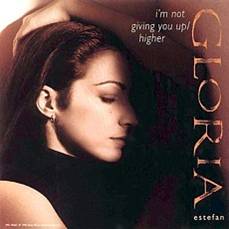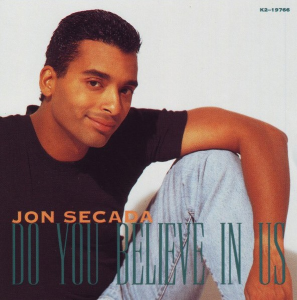
Juan Francisco Secada Ramírez, better known as Jon Secada, is a Cuban-born American singer, songwriter and record producer. He has won two Grammy Awards and sold 15 million records, making him one of the best-selling Latin music artists. His music fuses funk, soul music, pop, and Latin percussion.

"Hold Me, Thrill Me, Kiss Me" is a song written by Harry Noble and originally performed by Karen Chandler in 1952. It has been re-recorded several times since then, the most notable covers being by Mel Carter in 1965 and Gloria Estefan in 1994.

"Don't Wanna Lose You" is a song by Cuban-American singer-songwriter Gloria Estefan, released on June 21, 1989 as the first single by Epic Records from her debut solo album, Cuts Both Ways (1989). The song is written by Estefan and produced by her husband, Emilio Estefan, Jr. It reached number one in the US, where it became her second number-one single on the US Billboard Hot 100 and was also certified Gold.

"Get on Your Feet" is a song by Cuban-American singer and songwriter Gloria Estefan. It was released on September 30, 1989 by Epic Records in the US, Japan, and the UK, and in 1990 in Europe as the second single from her debut solo album, Cuts Both Ways (1989). The song was written by John DeFaria, Jorge Casas and Clay Ostwald, and produced by Emilio Estefan, Jr., Casas and Ostwald. A rerecorded version was included on her 2020 album Brazil305.

"Here We Are" is a song by Cuban-American singer-songwriter Gloria Estefan. It was released in 1989 in the United States and in 1990 to the rest of the world as the third single of her debut solo album, Cuts Both Ways (1989). It was released with the B-side song "Don't Let The Sun Go Down On Me", that was included on the European version, later to appear on the Hold Me, Thrill Me, Kiss Me album. A Portuguese version of the song, "Toda Pra Você," is included on the compilation Exitos De Gloria Estefan as well as the Brazilian edition of the Cuts Both Ways album. As a duet for her special television concert All The Way Concert, Celine Dion performed this song, while Estefan sang Dion's song, "Because You Loved Me". A new Spanish version called "Tu y yo" was released in July 2019 on Estefan's official YouTube channel, celebrating the 30th anniversary of the song. This version was also included on her 2020 album Brazil305. The intro sequence mirrors the song "Under Wraps #2" by Jethro Tull.

"Oye Mi Canto (Hear My Voice)" is a song by Cuban-American singer-songwriter Gloria Estefan, released as a single from her debut solo album, Cuts Both Ways (1989). In the US, it was the fourth single from the album and was released in April 1990. It was the second single in the UK, released on September 4, 1989, and throughout Europe in September and October 1989.

"Coming Out of the Dark" is a song by Cuban-American singer and songwriter Gloria Estefan. It was released on January 10, 1991, worldwide by Epic Records as the leading and first single from her second album, Into the Light (1991). It was written by Estefan with her husband Emilio Estefan, Jr. and Jon Secada, and produced by Estefan Jr., Jorge Casas and Clay Ostwald. It became the singer's third number one in the United States and second number one in Canada. The song is a soul ballad which includes the use of a choir. Among the voices in the choir are Estefan's colleague, the Cuban singer Jon Secada, and the R&B singer Betty Wright. The song's accompanying music video received heavy rotation on MTV Europe.

"Can't Forget You" is a song by Cuban-American singer-songwriter Gloria Estefan, released in June 1991 by Epic as the third single from her second solo album, Into the Light (1991), and at the same time as "Remember Me with Love" in the UK. Written by Jorge Casas, Clay Ostwald and Jon Secada, the single covered almost all the other countries where Estefan released the album, including Australia, Japan, Philippines, Spain, Canada and the United States. "Nayib’s Song " was also released in some European markets as the third official single from the album. The song is much in the style of her earlier songs like "Can't Stay Away from You" or "Don't Wanna Lose You". It peaked at number 43 on the US Billboard Hot 100, but reached number two on the Billboard Adult Contemporary chart. No remixes were created for this song. In the UK, "Can't Forget You" was included as a B-side on the single "Go Away", released in 1993.

"Always Tomorrow" is a song by Cuban American singer and songwriter Gloria Estefan, released worldwide on October 12, 1992 as the first single by Epic Records from her compilation album, Greatest Hits (1992). The song is written by Estefan and produced by her husband Emilio Estefan, Jr., Jorge Casas and Clay Ostwald. It is a guitar-driven acoustic ballad about starting over in the wake of tragedy or disaster. While on tour, Estefan has played the guitar while singing the song. She donated royalties from single sales to the victims of Hurricane Andrew. In 2005, the song was featured in a medley with her No. 1 smash "Coming Out of the Dark" in the compilation "Hurricane Relief: Come Together now", created for Hurricane Katrina disaster relief.

"Reach" is a song by Cuban-American singer and songwriter Gloria Estefan, released in April 1996 by Epic Records. It was co-written by Estefan with Diane Warren and served as the official theme song of the 1996 Summer Olympics held in Atlanta, Georgia in the United States. The single was included on the official Atlanta 1996 album, Rhythm of the Games, and later on Estefan's seventh studio album, Destiny (1996). It became a European hit, peaking within the top 10 in the Czech Republic, Hungary, Norway, and Spain, where it reached number two. In the UK, it peaked at number 15, while on the Eurochart Hot 100, the song reached number 47 in June 1996. Outside Europe, it peaked at number 23 in Australia as well as number 42 on the US Billboard Hot 100. "Reach" was nominated for a Grammy Award for Best Female Pop Vocal Performance at the ceremony in 1997, but lost out to Toni Braxton's "Un-Break My Heart", which was also written by Diane Warren. The accompanying music video for the song was directed by Marcus Nispel and made in two different edits.

"Go Away" is a song by Cuban American singer and songwriter Gloria Estefan. It was released in April 1993 as the fourth and last single worldwide and third to the United States from her fourth solo album and second compilation, Greatest Hits (1992). The song is much in the style of Estefan's earlier songs with the Miami Sound Machine. It was a club hit throughout Europe and America and was featured in the 1993 film Made in America, starring Whoopi Goldberg and Ted Danson, and its soundtrack. It reached the UK Top 20 and US Dance Chart Top 5.

"Heaven's What I Feel" is a 1998 song by Cuban American singer and songwriter Gloria Estefan, released as the lead single from her eighth studio album, gloria! on May 5, 1998 by Epic Records. The song was written by Kike Santander originally for Celine Dion. It was produced by Emilio Estefan, Jr. and Santander. The song is an up-tempo dance-pop, house and dance song.

"I'm Not Giving You Up" is a 1996 song by Cuban American singer and songwriter Gloria Estefan, released as the third single from her seventh studio album, Destiny (1996). It was popular more by its single remix by Tony Moran, which later was included on Estefan's 2001 Greatest Hits Vol. II compilation instead of its original version. In the US, the song was released as a double single along with "Higher". In Europe, it was released to coincide with the European leg of Estefan's Evolution World Tour. "I'm Not Giving You Up" peaked at number 11 in Spain, number 28 in the UK and number 33 in Scotland. In the US, the song reached number 40 on the Billboard Hot 100.

Jon Secada is the English-language debut album by Cuban American pop singer Jon Secada, released in 1992. The album features four singles that reached the Top 40 on the US Billboard Hot 100 or the Top 10 on Billboard's Adult Contemporary chart, including "Just Another Day", which was also a big hit worldwide. The album was certified 3× Platinum by the RIAA. It peaked at number 15 on the Billboard 200 album chart in March 1993. At the 5th Lo Nuestro Awards, the album won the award for "Pop Album of the Year".

Otro Día Más Sin Verte, also called Sentir in Spain, is the Spanish-language debut album by Cuban singer Jon Secada. It was released on October 6, 1992, by EMI Latin to coincide with his English-language self-titled debut album, which was released in April 1992. The idea to release an all Spanish-language album was pitched by Secada's music mentor Emilio Estefan, after realizing that SBK Records have yet released such an album. Estefan presented Secada's proposal for a Spanish-language recording to the head of SBK, Charles Koppelman and then president of EMI Latin Jose Behar. Koppelman accepted the proposal after Behar stated that he could see "market potential" for Secada. With the help of Emilio's wife, Gloria Estefan, Secada translated selected compositions from his English-language debut album for Otro Día Más Sin Verte.

"Just Another Day" is a song Cuban singer-songwriter Jon Secada recorded for his debut studio album, Jon Secada (1992). Secada and Miguel Morejon wrote the song, and SBK Records released it as the album's lead single in March 1992. The subject of this pop-soul-and-Latin-influenced ballad is the protagonist's deep desire to be with his lover and his inability to find happiness or contentment without them. Its music uses minor keys, piano melodies, and dramatic vocal performances, and a catchy hook serves as its foundation, "Just Another Day" combines a seductive, rhythmic cadence under Secada's baritone-tenor vocal range that is enveloped by a simple song structure.

"Can't Stay Away from You" is a song by Gloria Estefan and Miami Sound Machine. The song was released in November 1987 by Epic as the third single from their multi-platinum album, Let It Loose (1987). It became the group's fifth top 10 hit in the United States, peaking at #6 on the US Billboard Hot 100 chart; it was their second #1 hit on the adult contemporary chart, following 1986's "Words Get in the Way". The song originally peaked at #88 on the UK Singles Chart in May 1988, however the song was re-released after the success of its follow-up, "Anything for You", peaking at #7 in March 1989.

"Angel" is a song recorded by Cuban singer-songwriter Jon Secada for his eponymous debut studio album, Jon Secada (1992). Written by Secada and Miguel Morejon, SBK Records released it as the album's third single in January 1993 by EMI Latin and SBK. The Spanish version of "Angel" served as the second single of the album. The recording was inspired by a real-life experience that Secada encountered during a concert in Amsterdam. A downtempo romantic soul pop ballad, the track portrays a traditional storyline in which a man goes through the conclusion of a relationship, paying tribute to what he calls a lasting love.

"Do You Believe in Us" is a song by Cuban recording artist Jon Secada for his debut self-titled studio album and for his debut Spanish-language album Otro Día Más Sin Verte (1992). It was released in late 1992 as the third single from his Spanish-language album. The English version peaked at number 13 on the US Billboard Hot 100 and number three on the US Billboard Hot Adult Contemporary chart, while the Spanish version peaked at number one on the US Billboard Hot Latin Tracks chart. The song was also successful in Canada, reaching number three and topping the Adult Contemporary chart for one week. It was composed by Secada, Miguel Morejon, and Joseph Stefano, while Emilio Estefan Jr. produced the piece.
"Sentir" is a song recorded by Cuban recording artist Jon Secada for his debut self-titled studio album and for his debut Spanish-language album Otro Día Más Sin Verte (1992). It was released in 1993 as the fourth single from his Spanish-language album. The Spanish version peaked at number one on the US Billboard Hot Latin Tracks chart, making Secada the first Hispanic artist to do so. It was composed by Secada, Miguel Morejon, and Joseph Stefano, while Emilio Estefan Jr. produced the piece.



















